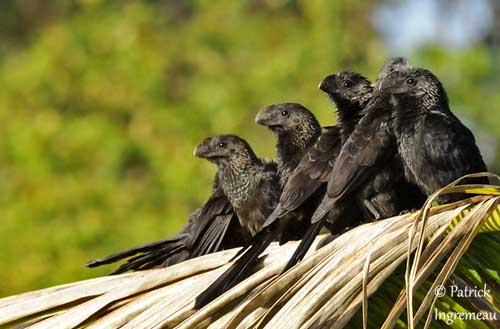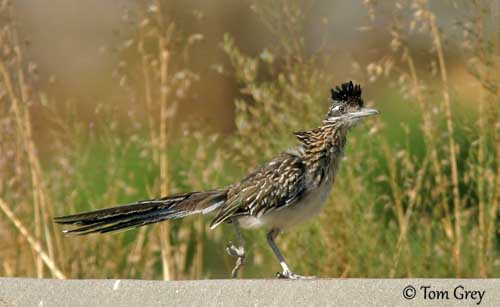
Each subfamily will be studied step by step in the following pages.
Photographers :
José Luis Beamonte
Pájaros de España
Jean Michel Fenerole
Photos d’Oiseaux du monde
Tom Grey
Tom Grey's Bird Pictures
Patrick Ingremeau
TAMANDUA
Ingo Waschkies
Bird Photography
Callie de Wet
GALLERY
Philippe et Aline Wolfer
GALERIE
Text by Nicole Bouglouan
Sources :
HANDBOOK OF THE BIRDS OF THE WORLD vol 4 by Josep del Hoyo-Andrew Elliott-Jordi Sargatal - Lynx Edicions - ISBN: 8487334229
L’ENCYCLOPEDIE MONDIALE DES OISEAUX - Dr Christopher M. Perrins - BORDAS - ISBN: 2040185607
CREAGUS@Monterey Bay (Don Roberson)
Wikipedia, the free encyclopaedia
Cuculidae Family
Introduction
Cuckoos, malkohas, couas, coucals, roadrunners, lizard cuckoos…
This large family includes between 135 and 147 species according to the classifications. These birds are highly variable in their different behaviours, especially in reproduction and nesting habits, but in their appearance too, although they share several similar features.
The Cuculidae family includes six subfamilies:
Cuculinae: Old Worlds parasitic cuckoos
Phaenicophaeinae: malkohas and couas
Centropodinae: coucals
Coccyzinae: American cuckoos
Crotophaginae: anis
Neomorphinae: New World ground cuckoos
The Cuculinae subfamily includes the Old World parasitic cuckoos. Most species are migratory. Their wings are long, narrow and pointed, and the graduated tail is fairly long too. The legs are short with feathered tarsus base.
The feet are zygodactyl with two toes backwards and the other two forwards, as in most Cuculidae species.
Numerous Old World parasitic cuckoos have dull plumage and cryptic colours, very helpful to detect the future host species. However, some of them, such as the male of the African species, have glossy, metallic plumage colours.
The female may have barred plumage pattern. The juveniles are streaked, whereas the chicks are naked at hatching.


Clamator glandarius
Chrysococcyx caprius
The Phaenicophaeinae subfamily gathers the non-parasitic cuckoos of the Old World Tropics, especially those of southern Asia. These have short, rounded wings. The long graduated tail is tipped with conspicuous spots and bars.
The malkohas are long-tailed, arboreal forest species. Most of them show brightly coloured bare skin on face and around the eyes. The large bill is curved and brightly coloured too. The feathers often show contrasted colours on the wings.
The three species of genus Carpococcyx of southern Asia are placed in this subfamily. They are large ground cuckoos with similarities in plumage pattern and nesting habits with the malkohas.

Coral-billed Ground Cuckoo
Carpococcyx renauldi
The couas are large cuckoos with soft brown and rufous plumage, except the blue plumage of the Blue Coua (Coua caerulea). They have long tail and large feet, and also bright coloured bare skin around the eyes. As the malkohas, they have long eyelashes. The couas are endemic to Madagascar.

Coua ruficeps
The Centropodinae subfamily includes the coucals. These birds are large and heavy-bodied, with long, strong feet, often with a long straight claw on the inner hind toe. The wings are short but the tail is long and broad. Their plumage is usually black, rufous-brown or whitish, or a combination of the three colours.
Coucals are found in the Old World tropics, from Africa and Asia to Australia, New Guinea and Salomon Islands. This group contains birds with the largest size of the family.


Burchell's Coucal
Centropus burchellii
Centropus sinensis
In the New World, the Coccyzinae subfamily includes the American cuckoos. They are the counterpart of the Old World Phaenicophaeinae, and have long, graduated tail too. They are mainly arboreal and insect-eaters.
Several are living on Caribbean Islands. They are large-bodied cuckoos. Some species have long wings and migrate over long distances between North and South Americas, or between north and south of South America. They are nest-building species.


Piaya cayana
Ash-colored Cuckoo
Coccycua cinerea
The Crotophaginae subfamily gathers nesting, group-living cuckoos. These birds have thick bill and legs, and long tail.
The three Crotophaga species have black plumage whereas the Guira Cuckoo (Guira guira) from South America is streaked brown.
The strong smell of the anis may attract the predators, especially at roosts where they are sleeping together at night. Due to wings and tail “disconnected” from the body, they move with rapid jerky movements. They are slow and clumsy when they move through the bushes. Their flopping wings and weaving tail often flush insects in the vegetation.
On the other hand, the Guira Cuckoo is more graceful in flight.


Crotophaga ani
Guira guira
The Neomorphinae subfamily includes the New World ground-cuckoos. These birds have long legs and tail. Most of them are nest-builders, but three species are brood parasites.
The roadrunners, or lizard-cuckoos, feed on lizards and may run at speeds of up to 30 km/ hour when chasing their preys. They run with head and tail held at ground-level, and swinging tail. They often run along roads, paths, or dry river-beds.


Geococcyx californianus
Striped Cuckoo
Tapera naevia